As a jewelry connoisseur, I have been consistently on the lookout for unique and beautiful pieces that align with my ethical and eco-conscious values. In recent times, there has been a significant increase in sustainable jewelry materials for artisans, allowing us to indulge in eco-friendly jewelry materials without sacrificing our commitment to the environment and society.
These ethical jewelry choices encompass a broad spectrum of handcrafted and artisanal jewelry materials, showcasing innovation, creativity, and responsibility. Brands like AGMES, SVNR, Akola, Alighieri, Zoë Chicco, Laura Lombardi, Grace Lee, Katkim, Meadowlark, Wwake, Monbouquette, Pamela Love, Monica Rich Kosann, Daniella Samper, and numerous others are paving the way for a brighter, greener future in the jewelry industry.
Key Takeaways
- Increasing interest in sustainable jewelry materials for artisans
- Eco-friendly jewelry materials promote environmental and social responsibility
- A broad range of materials, from recycled metals to lab-created gemstones
- Real brands leading the sustainably-focused industry, e.g., Laura Lombardi, Grace Lee, and Katkim
- Ethical jewelry choices appealing to conscientious, environmentally aware consumers
Top 15 Eco-Friendly and Sustainable Jewelry Materials
In the world of jewelry making, the focus on sustainability and environmental responsibility has never been greater. To meet this growing demand, artisans and manufacturers are turning to a variety of eco-friendly and sustainable materials, each offering a unique combination of beauty and ethical sourcing. Here is a list of 15 such materials commonly used in jewelry making:
- Recycled Metals: Includes gold, silver, and platinum, sourced from repurposed jewelry or industrial uses.
- Lab-Grown Diamonds: Diamonds grown in a lab setting, reducing the environmental impact of mining.
- Wood from Managed Forests: Sourced from forests that are sustainably managed to ensure minimal ecological impact.
- Ethically Sourced Gemstones: Gemstones obtained from mines that maintain ethical labor practices and environmental standards.
- Recycled Glass: Made from repurposed glass materials, reducing waste and energy consumption.
- Organic Cotton Cord: Used in place of synthetic materials for stringing beads and pendants.
- Bamboo: A rapidly renewable resource used for its durability and lightweight properties.
- Cork: Harvested from cork oak trees without harming the tree, a sustainable and biodegradable material.
- Sea Glass: Naturally tumbled glass found on beaches, often used in unique, handcrafted pieces.
- Hemp: A sustainable crop that requires minimal pesticides and water to grow, used for cords and textiles in jewelry.
- Upcycled Fabrics: Repurposing scrap fabric from the textile industry for decorative elements in jewelry.
- Bioplastics: Made from renewable biomass sources, used for beads and other decorative elements.
- Pearls from Sustainable Aquaculture: Cultivated in environments that maintain the health of marine ecosystems.
- Vintage and Antique Elements: Reusing old jewelry pieces or components, which reduces the need for new resources.
- Tagua Nuts: Often referred to as vegetable ivory, a sustainable and cruelty-free alternative to animal ivory.
These materials are not only environmentally friendly but also offer unique aesthetics and stories, adding extra value to the jewelry pieces made from them.
Locally-Sourced Materials: According to Ecocult, SOKO artisans use locally-sourced and eco-friendly materials such as recycled brass and reclaimed cow horn and bone, which are more sustainable and support local communities.
The Importance of Sustainability in the Jewelry World
The sustainability movement within the jewelry industry is vital to mitigate the environmental damage and human rights violations historically associated with jewelry production. The use of toxic chemicals in gold extraction, the environmental devastation from diamond mining, and the inhumane conditions in some mining operations are critical concerns.
Sustainable jewelry means prioritizing the welfare of miners and factory workers, minimizing environmental impact, and employing practices that are both fair to the planet and its people. Certifications like Fairtrade, Fairmined, and the Institute for Responsible Mining Assurance help consumers identify jewelry brands that are genuinely committed to ethical and sustainable practices.
“Sustainable jewelry means prioritizing the welfare of miners and factory workers, minimizing environmental impact, and employing practices that are both fair to the planet and its people.”
By adopting ethical jewelry practices and selecting ethically-sourced materials, brands can take a significant step toward reducing their environmental footprint and fostering a community of responsible jewelry making. Here are some vital steps in the importance of sustainability in the jewelry industry:
- Using recycled precious metals and reducing the need for new mining projects.
- Embracing lab-created diamonds and gemstones, which require fewer resources and avoid ethical concerns related to traditional mining.
- Participating in certifications like Fairtrade or Fairmined to ensure the welfare of mining communities and environmentally responsible practices.
- Choosing eco-friendly packaging and reducing waste in production processes.
- Opting for renewable and biodegradable materials, which reduce the environmental impact of disposed jewelry items.
| Steps Towards a Sustainable Jewelry Industry | Examples/Implementations |
|---|---|
| Recycled Precious Metals | Zoë Chicco, AGMES |
| Lab-created Diamonds and Gemstones | Grace Lee, Wwake |
| Fairtrade or Fairmined Certification | Daniella Samper, Alighieri |
| Eco-friendly Packaging | Akola, Meadowlark |
| Renewable and Biodegradable Materials | SVNR, Laura Lombardi |
The jewelry industry is starting to recognize the importance of sustainability and the need for change. By choosing sustainable materials and adopting ethical practices, brands can contribute to a healthier planet and a better future for the entire industry.
Recycled Precious Metals: Turning Old into New
As the world focuses on sustainability, the need for eco-friendly materials in jewelry-making, such as recycled gold, remains at the forefront. By transforming old metal into stunning pieces of art, skilled artisans can create sustainable fine jewelry while minimizing their environmental impact and promoting a greener future in the industry.
Recycled Gold and Its Lustrous Appeal
Recycled gold has become a lustrous, eco-friendly alternative appealing to both artisans and consumers. Jewelry brands like Zoë Chicco have garnered attention for using 100% recycled gold in their designs. This not only maintains high ethical standards but also demonstrates a commitment to transparency, affordability, and local production.
“I choose to use recycled gold not only because it’s better for the environment but also because it’s just as beautiful as newly mined gold. It’s a sustainable choice we can all feel good about.”
By opting for recycled gold, brands can create ethical and beautiful pieces without compromising on quality or design. This practice allows for increased customer trust and supports the goals of a sustainable jewelry industry.
Shining the Spotlight on Recycled Silver and Platinum
Recycled silver and platinum have also gained momentum in recent years, with innovative companies like AGMES and Laura Lombardi using these materials to craft unique, expressive jewelry. The process not only minimizes waste but also supports local manufacturing efforts.
Key benefits of using recycled silver and platinum include:
- Reduced environmental impact from mining
- Conservation of natural resources
- Promotion of responsible sourcing and ethical practices
- Enhanced transparency in the supply chain
- Bolstering local economies and supporting skilled artisans
With the surge in demand for sustainable precious metals, embracing recycled silver and platinum can propel the industry towards a more eco-friendly future, one lustrous piece at a time.
Lab-Created Diamonds and Gemstones: Ethical Brilliance
As the jewelry industry continues to evolve, lab-created diamonds have emerged as an ethical and sustainable alternative to traditionally mined stones. These conflict-free diamonds offer brilliance without the environmental or humanitarian cost associated with mining.
Demystifying Lab-Created Diamonds
Lab-created, or synthetic, diamonds are grown in a controlled environment using advanced technological processes that replicate the conditions under which natural diamonds form. The result is a stone with identical chemical, physical, and optical properties to a mined diamond. Grace Lee, a prominent jewelry designer, utilizes lab-created diamonds in her designs, showcasing the move towards more conscious and responsible jewelry crafting.
Fairmined Gold: The Eco Hub emphasizes the use of Fairmined gold in jewelry, which is ethically sourced from small-scale artisanal mines. This type of gold supports the well-being of miners and their communities by ensuring fair wages and contributing to better health care, education, safety, and living conditions.
Eco-friendly engagement rings and fine jewelry pieces made with lab-created diamonds have gained popularity among consumers who appreciate the sustainable and ethical aspects of these stones. Choosing lab-created diamonds means supporting a kinder approach to the planet without compromising on quality or aesthetics.
The Colorful World of Lab-Created Gemstones
Similarly, the vibrant world of lab-created gemstones offers a vast array of sustainable options for artisans and consumers. By using cutting-edge technology, scientists can grow synthetic gemstones that closely resemble their natural counterparts in terms of appearance, structure, and composition.
“Lab-created gemstones are not only visually stunning but also serve as testaments to an industry shifting towards ethical and ecologically responsible practices.”
The following table illustrates the main differences between lab-created and natural gemstones:
| Criteria | Lab-Created Gemstones | Natural Gemstones |
|---|---|---|
| Environmental Impact | Significantly lower | Higher, due to mining and extraction processes |
| Humanitarian Concerns | Minimal, as gemstone production is controlled and regulated | Greater, due to potential unethical mining practices and working conditions |
| Price | More affordable, as production costs are lower | Generally higher, due to mining, transportation, and processing costs |
| Availability | Easier to source and produce, given the controlled process | Dependent on limited and variable natural resources |
By opting for jewelry crafted with lab-created gemstones, consumers can align their personal values with their aesthetic preferences, and contribute to a more ethical and sustainable jewelry industry.
Reviving Tradition with Reclaimed Wood and Organic Materials
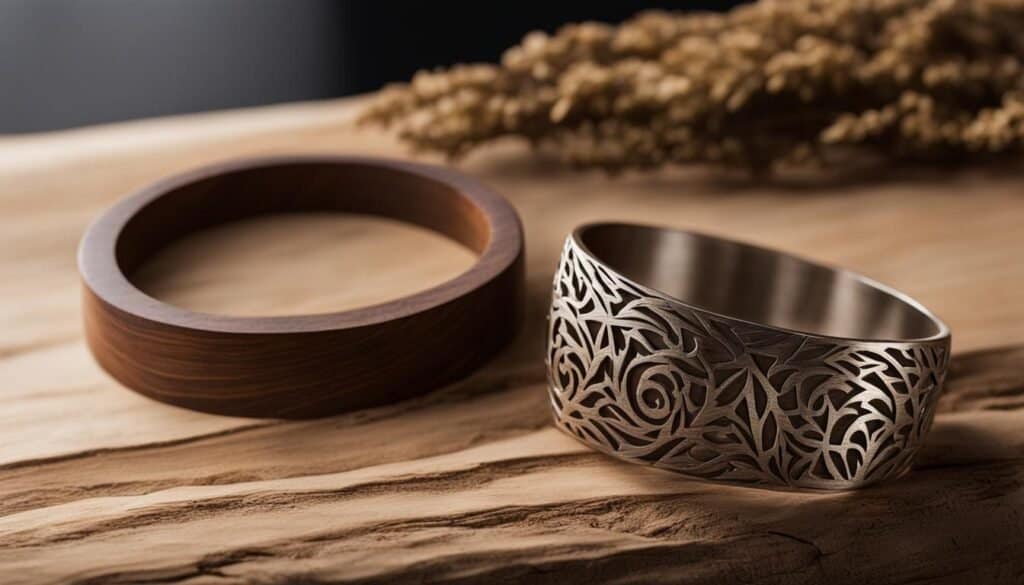
Artisans are breathing new life into traditional materials by incorporating reclaimed wood and organic elements into their jewelry designs. Utilizing these materials not only taps into heritage craftsmanship but also promotes conservation through the repurposing of existing resources. By doing so, fashionable pieces of reclaimed wood jewelry and various other wooden artisanal accessories are created.
Combining traditional sustainable materials with innovative designs, artisans are creating striking pieces that marry the past and the future, balancing age-old artistry with environmental responsibility.
Jewelry crafted from wood and other organic jewelry materials not only reflect an appreciation for the past but also a commitment to sustainability. The continued use of wooden artisanal accessories echoes a harmonious connection between the natural world and the creative spirit of the jeweler.
- Wooden bead necklaces made from reclaimed wood
- Eco-friendly wooden bracelets and bangles
- Hand-carved wooden pendants, earrings, and brooches
Moreover, artisans often pair these wooden components with other traditional sustainable materials, such as ethically sourced gemstones, recycled metals, and organic textiles, to craft stunning, eco-conscious pieces.
| Material | Examples | Sustainability Features |
|---|---|---|
| Reclaimed Wood | Salvaged teak, repurposed oak, reused maple | Conserves resources, reduces waste, preserves forests |
| Ethically Sourced Gemstones | Conflict-free diamonds, fair-trade sapphires, traceable rubies | Protects miners’ rights, promotes responsible mining practices, prevents environmental damage |
| Recycled Metals | Recycled gold, silver, platinum | Reduces waste, minimizes mining, supports local manufacturing |
| Organic Textiles | Organic silk, hemp, bamboo, linen | Biodegradable, renewable, pesticide-free, promotes sustainable agriculture |
In conclusion, the revival of traditional materials like reclaimed wood and organic elements in the world of jewelry reflects a growing movement towards sustainability and responsible creativity. By appreciating and preserving our heritage while keeping an eye on conservation and the environment, we can equip ourselves with beautiful and meaningful accessories, designed to stand the test of time.
Repurposed Treasures: The Art of Upcycling in Jewelry
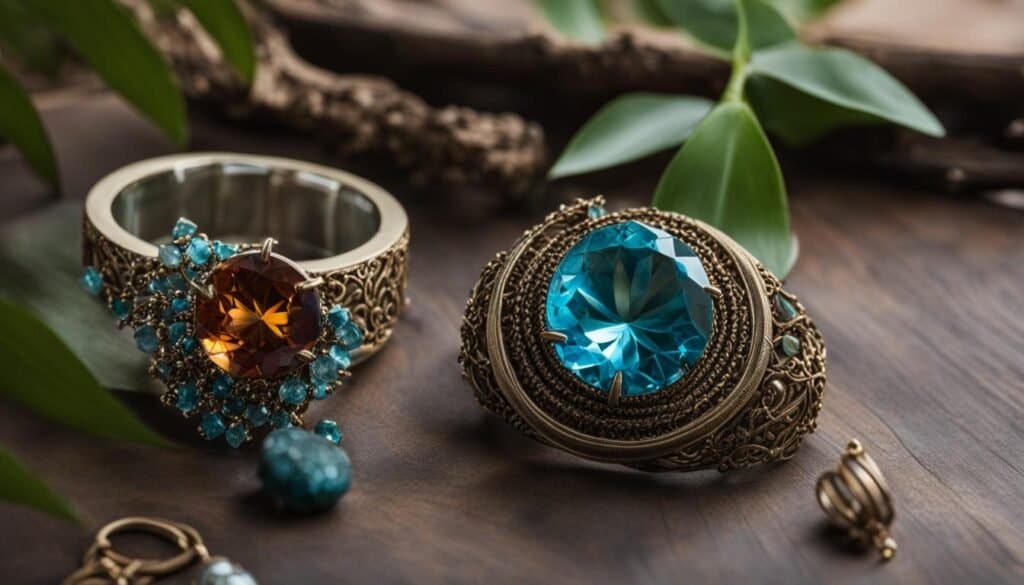
Upcycled jewelry has become increasingly popular with artisans and consumers who appreciate the art of repurposing and seek sustainable treasures in their accessories. The process upcycles vintage and found items, preventing them from becoming waste while creating unique and story-rich adornments. Brands like SVNR exemplify the fusion of ethics and aesthetics through their handcrafted jewelry made from upcycled and natural materials.
Embracing the creative potential of repurposing vintage items encourages the exploration of new forms of expression while reducing the environmental impact of the fashion industry. The following examples serve as creative inspiration for those interested in wearing or crafting upcycled jewelry:
- Antique watch parts: Disassembled and transformed into intricate steampunk-inspired earrings, necklaces, or cufflinks.
- Vintage buttons: Used to craft stunning rings or brooches, featuring unique patterns or designs that pay homage to the past.
- Old coins: Converted into pendants or charms, embracing the history and cultural heritage of various countries.
- Key charms: Reimagined as necklaces or earrings, symbolizing new beginnings or treasured memories.
Upcycling represents a creative approach to sustainability in jewelry, where artisans transform pre-existing objects into beautiful new adornments.
Moreover, vintage repurposed jewelry resonates with today’s movement towards a more conscious approach to fashion; each piece is endowed with a unique, personal character that merges elements of the past with contemporary designs. Businesses that specialize in upcycling jewelry often partner with artists, craftspeople, and other creators to provide socially responsible opportunities for income generation and creative expression.
In conclusion, upcycled jewelry is an innovative approach to both preserving vintage items and contributing to sustainability in the fashion industry. It offers a plethora of creative possibilities that elevate the appeal of ethical accessories while keeping them firmly rooted in their history, shaping the trends of eco-conscious consumers worldwide.
Fair Trade Practices: Supporting Artisanal Communities Globally
The growth of the sustainable jewelry industry has brought attention to the importance of fair trade practices in supporting artisanal communities around the world. By adhering to certifications like Fairmined and Fairtrade gold, conscientious artisans and brands are able to contribute positively to the livelihoods of miners and their communities while minimizing the negative environmental and humanitarian impacts of gold extraction.
Fairmined and Fairtrade Gold: Pioneering Ethical Standards
Fairmined gold and Fairtrade gold certifications embody the pinnacle of ethical standards in the jewelry industry. By sourcing certified gold, artisans ensure that each miner receives fair compensation, works in safe conditions, and employs environmentally responsible extraction and production methods.
“Daniella Samper’s eponymous brand exclusively uses Fairmined gold, demonstrating the utmost commitment to traceability, empathy towards the environment, and human life.”
The Human Touch: Fair Wages and Community Development
Beyond employing ethical materials, sustainable jewelry recognizes the importance of the people behind each piece. Fostering fair wages and community development in the jewelry industry is essential to elevating the value of each finished product beyond mere aesthetics and into the realm of true social impact.
- For example, the brand Akola actively contributes to economic development and women’s empowerment in Africa through employment, training programs, and educational initiatives.
- Designers like Pamela Love, Monica Rich Kosann, and others prioritize working with artisans who receive fair wages, creating a positive cycle of craftsmanship and skill development that uplifts communities and individuals alike.
By supporting ethical jewelry choices that honor Fairmined and Fairtrade gold standards, you not only invest in beautiful adornments but also advocate for the artisanal miners who dedicate their lives to bringing these precious materials to the world.
Biodegradable and Renewable Jewelry Materials
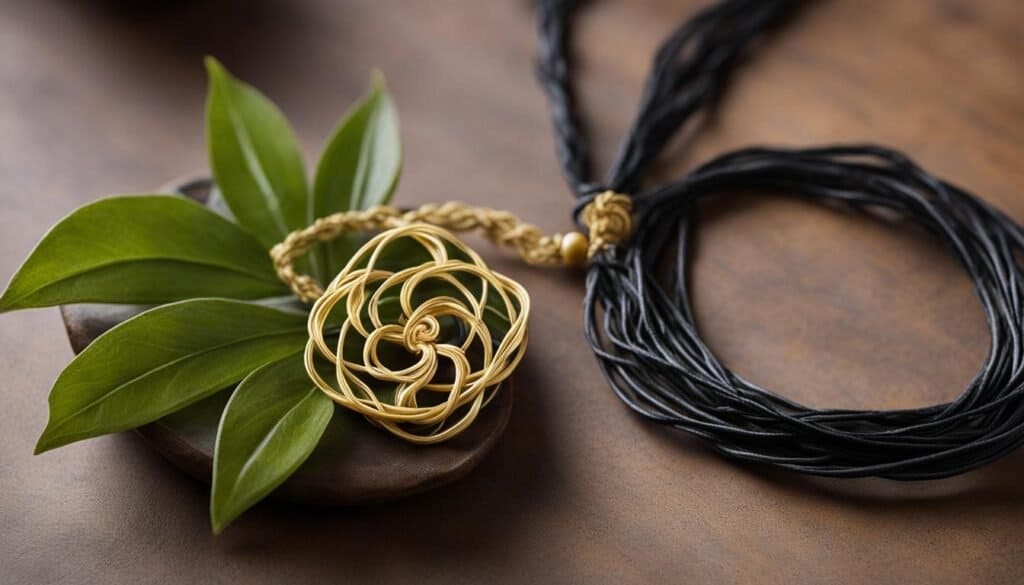
Transitioning to biodegradable and renewable materials is a positive step forward for the jewelry industry. Materials like hemp and beeswax exemplify the use of nature’s offerings to create sustainable and environmentally benign jewelry. These materials break down naturally, reducing the environmental impact and promoting a more sustainable and ethical ecosystem in jewelry making.
From Hemp to Beeswax: Wearing Nature’s Best
Harnessing nature’s bountiful resources, jewelry artisans are experimenting with biodegradable jewelry materials like hemp and beeswax to create innovative and eco-friendly designs. By using renewable jewelry materials, artists help pave the way to a more ethical and environmentally conscious fashion industry.
- Hemp jewelry: Hemp, a fast-growing plant with minimal water requirements, serves as an ideal material for creating nature-friendly jewelry. Its strong and durable fibers can be intricately woven to form stunning bracelets, necklaces, and earrings. As a biodegradable and renewable material, hemp enables artisans to make a bold ecological statement without compromising on style.
- Beeswax in crafting: Beeswax, a natural and non-toxic byproduct of honey production, provides a unique and sustainable solution for crafting intricate and organic jewelry pieces. Combined with other materials, beeswax can create stunning wearable art that bears a low ecological footprint.
“We do not inherit the earth from our ancestors; we borrow it from our children.” – Native American proverb
Many jewelry artisans and designers are taking inspiration from their surrounding environment and incorporating renewable materials like hemp and beeswax into their creations. In doing so, they are paving the way for a future where sustainable fashion is not just a trend, but a standard that every jeweler can strive for.
Eco-Friendly Packaging and Responsible Brand Practices
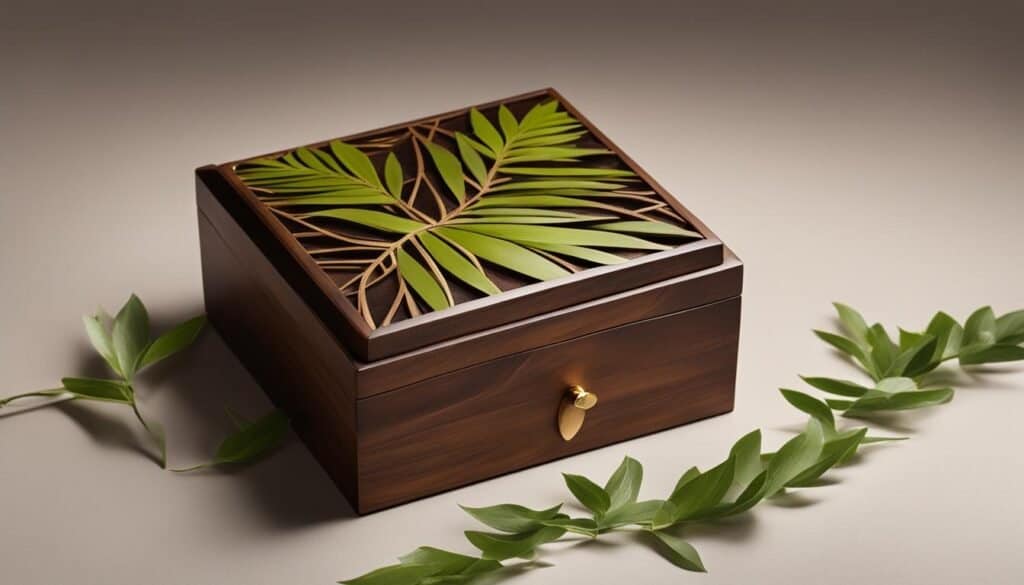
The growing demand for sustainable and ethically sourced jewelry has led eco-conscious brands to focus on not just the jewelry itself, but also the entire customer experience. This includes adopting eco-friendly packaging, responsible brand practices, and sustainable jewelry boxes to reduce the overall environmental impact. The following examples showcase these initiatives:
- Using recycled packaging materials: Many brands such as Monica Rich Kosann and Pamela Love utilize recycled packaging materials, including paper and cardboard, for jewelry boxes and shipping containers.
- Opting for biodegradable materials: Some brands incorporate biodegradable materials like plant-based plastic alternatives and compostable paper in their packaging, ensuring a reduced environmental impact.
- Streamlining operations: By implementing more efficient practices in production and logistics, companies can reduce waste, maximize the use of resources, and minimize their carbon footprint.
Achieving sustainability in the jewelry industry is not simply about the products we create, but also about the way we present and deliver them to our customers.
A holistic view of sustainability extends beyond the jewelry materials and production process to encompass every aspect of the brand’s interaction with the environment and customers. By prioritizing eco-friendly packaging and embracing responsible practices, jewelry brands can demonstrate their commitment to preserving the planet and create a more sustainable future for the industry.
Moving Towards a Sustainable Jewelry Future
As the demand for ethical jewelry choices increases, artisans and brands are committed to crafting with conscience, embracing eco-friendly and sustainable materials. By supporting this shift, eco-conscious consumers are helping create a sustainable future for the jewelry industry. From sourcing ethical precious metals and lab-created gems to championing fair trade practices and utilizing biodegradable elements, artisans are working tirelessly to ensure their masterpieces hold a smaller ecological footprint.
Notable brands such as AGMES, Zoë Chicco, and Grace Lee have pioneered responsible practices in the industry, inspiring others to follow in their footsteps. By opting for lab-created diamonds and recycled metals, these artisans are effectively reducing the environmental impact of mining and promoting a healthier planet. Additionally, with fair trade practices in place, these artists and craftsmen are making a difference in the lives of artisanal communities worldwide and empowering them to thrive through sustainable methods.
Our choices as consumers have the power to catalyze positive change within the jewelry market. By choosing to support sustainable brands and materials, we contribute to an ongoing cycle of progress, ensuring a harmonious balance between the beauty of jewelry production and the well-being of our planet and its inhabitants.
FAQ on Sustainable Jewelry Materials for Artisans
Q: What are some sustainable materials used in jewelry making?
A: Sustainable jewelry materials include recycled metals, responsibly sourced gemstones, ethically harvested pearls, and organic materials such as wood, bone, and shell.
Q: How can I find sustainable jewelry options?
A: You can find sustainable jewelry options by researching and supporting ethical jewelry brands, looking for products made from recycled materials, or choosing handmade jewelry from local artisans.
Q: What does sustainable jewelry mean?
A: Sustainable jewelry refers to jewelry that is made in an environmentally and socially responsible manner, using materials and processes that have minimal negative impact on the planet and its inhabitants.
Q: What are some ethical jewelry brands known for their sustainable practices?
A: Some reputable ethical jewelry brands that are recognized for their sustainable and ethical practices include brands that are members of the Responsible Jewelry Council, companies that use recycled materials, and those that support local artisans.
Q: Why should I choose sustainable jewelry over traditional jewelry?
A: By choosing sustainable jewelry, you are supporting environmentally friendly and ethical production practices. Sustainable jewelry also often utilizes recycled materials and promotes fair trade, making it a more responsible choice.
Q: How can I make sure the jewelry I buy is sustainable and ethical?
A: You can ensure the sustainability and ethical standards of jewelry by looking for certifications such as the Responsible Jewelry Council, verifying the use of recycled materials, and purchasing from brands known for their ethical and sustainable practices.
Q: What are some key characteristics of a sustainable jewelry brand?
A: A sustainable jewelry brand is characterized by its use of recycled and responsibly sourced materials, transparent and ethical production processes, support for local artisans, and commitment to minimizing its environmental impact.
Q: Where can I find affordable sustainable jewelry brands?
A: You can find affordable sustainable jewelry brands by exploring local artisan markets, supporting small independent jewelry makers, and seeking out online platforms that specialize in sustainable and ethical jewelry options.
Q: How can I ensure that the jewelry I’m interested in is made from recycled materials?
A: You can ensure that the jewelry is made from recycled materials by checking the product descriptions, asking the jewelry manufacturer directly, or looking for certifications and labels showcasing the use of recycled materials.
Q: What are some benefits of buying sustainable jewelry?
A: Buying sustainable jewelry supports eco-friendly practices, reduces the demand for newly mined materials, promotes ethical production standards, and allows you to contribute to a more environmentally conscious jewelry industry.

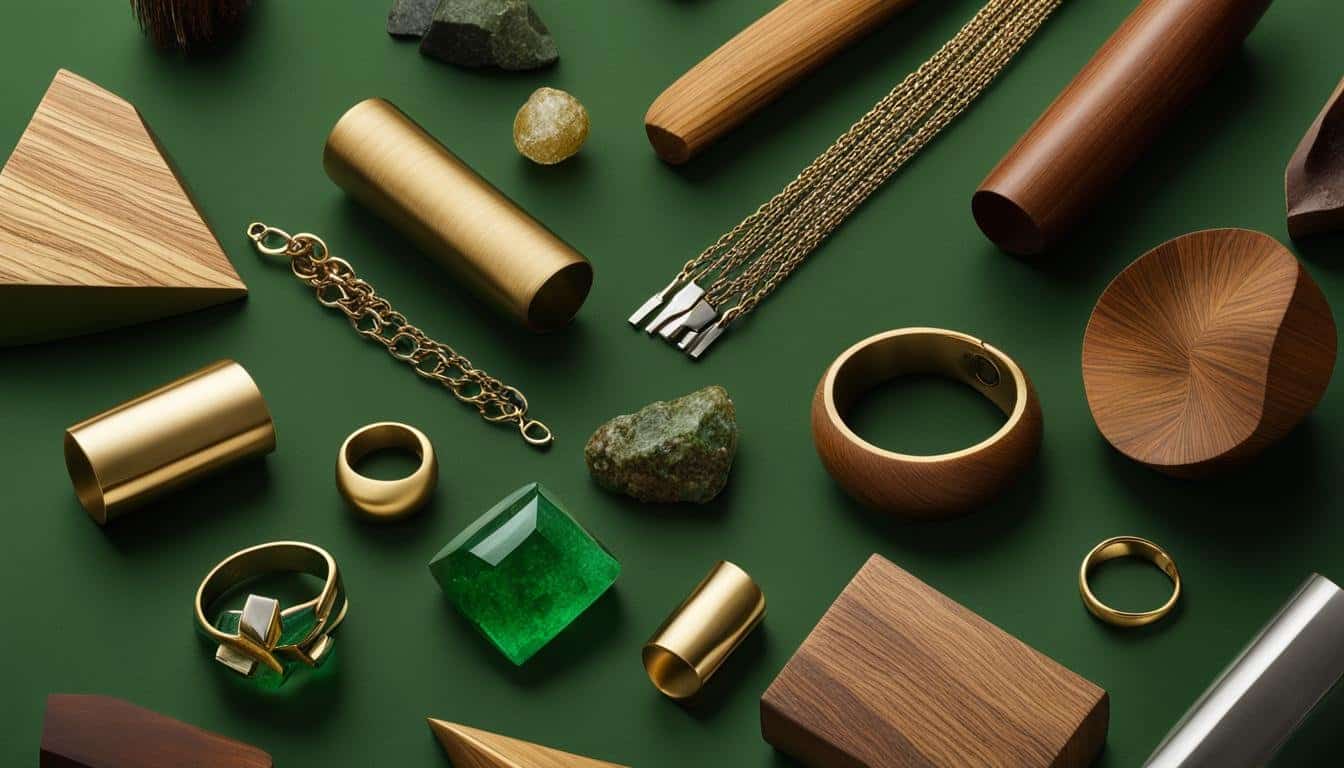



Leave a Reply